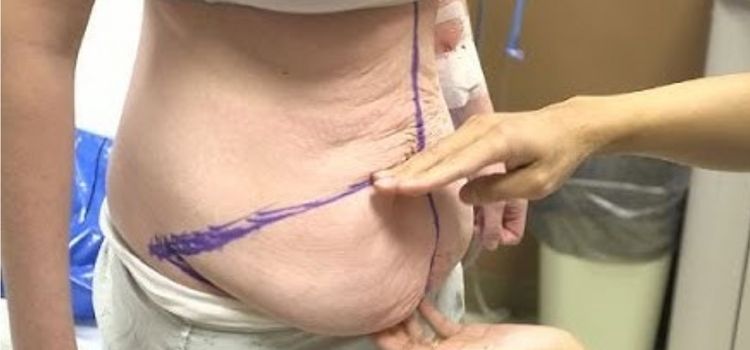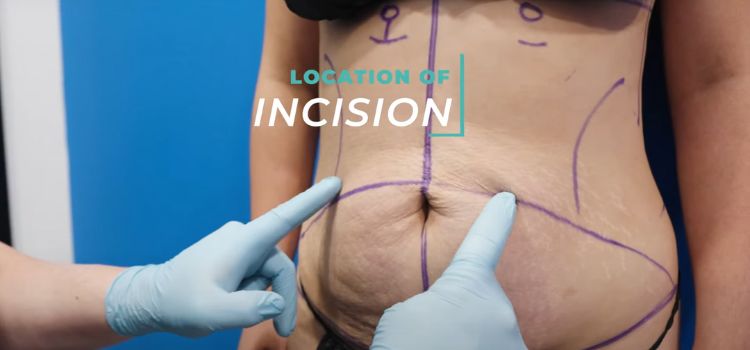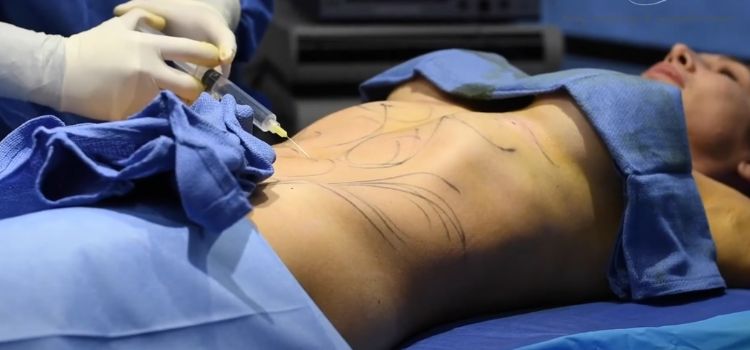No, it is not recommended to get a tummy tuck while breastfeeding because it can affect milk production and quality. When considering cosmetic surgery, it is important to prioritize the health and well-being of both the mother and the baby.

Recovering from a tummy tuck requires rest and time to heal, which may be difficult while breastfeeding. It is advisable to wait until you have finished breastfeeding before undergoing this procedure.
Consulting with a healthcare professional is essential to make an informed decision that considers your individual circumstances and prioritizes the safety of both you and your baby.
Understanding Tummy Tucks And Breastfeeding

If you’re wondering whether you can have a tummy tuck while breastfeeding, it’s essential to consider the potential risks involved. While some surgeons may exercise caution due to the impact on milk production and the healing process, individual circumstances can vary.
It’s crucial to consult with a qualified plastic surgeon and discuss your specific situation to make an informed decision.
A tummy tuck, also known as abdominoplasty, is a surgical procedure that can help improve the appearance of the abdominal area by removing excess skin and fat, and tightening the muscles.
This popular cosmetic surgery can be appealing for women who have experienced changes in their bodies due to pregnancy and childbirth.
However, for breastfeeding mothers, there are some important considerations to keep in mind.
What Is A Tummy Tuck And How Does It Work?
- Tummy tuck, or abdominoplasty, is a surgical procedure performed to enhance the appearance of the abdominal area.
- It involves the removal of excess skin and fat from the abdomen.
- The procedure also tightens the muscles of the abdominal wall, providing a flatter and more toned appearance.
The Effects Of Pregnancy And Breastfeeding On The Abdominal Area
- Pregnancy and breastfeeding can cause significant changes to the abdominal area.
- The skin may stretch, resulting in loose and sagging skin postpartum.
- The abdominal muscles can also become stretched and separated during pregnancy, leading to a condition called diastasis recti.
- Hormonal changes during breastfeeding may affect the elasticity of the skin and impact the overall appearance of the abdomen.
Addressing Common Concerns About Tummy Tucks While Breastfeeding
Can I undergo a tummy tuck while breastfeeding?
- It is generally recommended to wait until you have finished breastfeeding before considering a tummy tuck procedure.
- Breastfeeding requires a high level of energy and nutrient intake, and undergoing surgery during this time can impact your body’s ability to heal properly.
- It is important to prioritize the health and well-being of both you and your baby.
What are the potential risks of undergoing a tummy tuck while breastfeeding?
- Surgical procedures involve the use of anesthesia and pain medications, which can be transferred to breast milk and potentially affect your baby.
- The recovery period after a tummy tuck may require you to limit physical activity and lifting, which could interfere with breastfeeding.
When is the best time to consider a tummy tuck?
- It is advisable to wait until you have finished breastfeeding and allowed your body to fully recover from pregnancy before considering a tummy tuck.
- This ensures that your body has returned to its normal hormonal and metabolic state, increasing the chances of a successful procedure and optimal healing.
Remember, every individual is different, and it is essential to consult with a qualified plastic surgeon who can assess your specific circumstances and provide personalized advice. Prioritizing your health and the well-being of your baby is paramount when making decisions about cosmetic procedures while breastfeeding.
Tummy Tuck And Milk Supply

It’s not uncommon for new moms to have lingering concerns about their post-baby bodies, even while breastfeeding. One question that often comes up is whether it’s possible to get a tummy tuck while breastfeeding.
In this section, we’ll debunk the myths surrounding tummy tucks and milk supply, discussing the potential risks and factors to consider. We’ll also take a look at the research and studies conducted on tummy tucks and breastfeeding.
Can Getting A Tummy Tuck Impact Milk Supply?
When it comes to tummy tucks and milk supply, many new moms worry that undergoing the procedure may have a negative effect on their ability to breastfeed their little ones. Let’s dive into the realities and clear up any misconceptions:
- Hormonal changes: During a tummy tuck, the abdominal muscles are tightened and excess skin is removed. This surgical procedure does not directly affect your body’s ability to produce milk. The hormones responsible for milk production are primarily influenced by the pituitary gland, which is not directly involved in the tummy tuck process.
- Surgical anesthesia: While the actual tummy tuck procedure itself does not impact milk supply, the anesthesia used during surgery can potentially affect breastfeeding. Some anesthesia medications may transiently inhibit milk production. It is vital to discuss this concern with your surgeon and anesthesiologist beforehand to ensure the safest possible options for you and your baby.
Before deciding on a tummy tuck while breastfeeding, consider the following factors:
- Baby’s age: If your baby is very young and heavily reliant on breastfeeding for nutrition, you may want to postpone the surgery until they are older and able to transition to solid foods more easily. This allows you to maintain their primary source of nutrition during the recovery period.
- Pumping and storing breast milk: If you do choose to undergo a tummy tuck while breastfeeding, it’s crucial to discuss strategies with your healthcare provider to maintain your milk supply. This may involve pumping and storing breast milk prior to the surgery, so your baby can continue to receive your precious milk during your recovery.
Research And Studies On Tummy Tucks And Breastfeeding
Research and studies have been conducted to shed light on the impact of tummy tucks on breastfeeding. Here are some key findings:
- A study published in the journal Plastic and Reconstructive Surgery followed a group of women who underwent tummy tucks while breastfeeding. The results showed that the procedure itself did not significantly affect milk production or quality.
- Another study in the journal Aesthetic Surgery Journal examined a group of women who had previously undergone tummy tucks before breastfeeding. The study found that their breastfeeding experiences were not negatively impacted, and they were able to successfully nurse their babies.
While these studies provide some insight, it is crucial to consult with your healthcare provider and a board-certified plastic surgeon who specializes in post-pregnancy body procedures.
Together, they can evaluate your individual circumstances and guide you through the decision-making process, ensuring the best outcome for both you and your baby.
Remember, every woman’s body and breastfeeding journey are unique. Prioritizing open communication with your healthcare team will help you make an informed decision that aligns with your personal goals and your baby’s well-being.
Safety Precautions And Timing Of Tummy Tuck
Although a tummy tuck may be a desired procedure for new moms, it is generally recommended to wait until after breastfeeding to ensure the safety of both mother and baby. Consult with a qualified healthcare provider for personalized advice.
Tummy tucks are a popular choice for individuals who want to regain their pre-pregnancy body after giving birth. However, if you are currently breastfeeding, you may be wondering if it’s safe to undergo this procedure while nursing.
We will discuss the safety precautions and timing involved in getting a tummy tuck while breastfeeding. It is important to note that it is always best to consult with your healthcare professional for personalized advice.
The Importance Of Waiting For The Right Time To Get A Tummy Tuck
- Giving your body enough time to heal: Your body undergoes significant changes during pregnancy and childbirth. It is crucial to allow for sufficient time to physically recover before considering any surgeries or invasive procedures.
- Prioritizing the health of your child: Breastfeeding is an important bonding experience for you and your baby, providing essential nutrients and immune-boosting properties. Putting your child’s well-being first should be a top priority when making decisions regarding any medical procedures.
- Ensuring optimal surgical outcomes: Waiting until you have completed your breastfeeding journey can contribute to better healing and provide your surgeon with a more stable foundation to achieve the desired cosmetic results.
Recommendations From Healthcare Professionals
- Consult with your plastic surgeon: Schedule a consultation with a board-certified plastic surgeon who has experience working with breastfeeding individuals. They will be able to assess your individual situation and provide you with the most accurate guidance based on your health, body type and specific needs.
- Inform your healthcare professional about your breastfeeding journey: Be open and transparent about your breastfeeding status, as this may influence the timing and approach of the tummy tuck procedure. Your healthcare professional needs to understand your unique circumstances to provide appropriate recommendations.
Tips For Maintaining Milk Supply During The Recovery Period
- Pump and store breast milk: Prior to your tummy tuck surgery, gradually build up a stash of breast milk by pumping and properly storing it. This will ensure that your baby has access to breast milk during your recovery period.
- Utilize a breast pump after surgery: A breast pump can help maintain and stimulate milk supply while you are unable to breastfeed directly. Make sure to follow your healthcare professional’s guidance on when it is safe to resume pumping post-surgery.
- Focus on rest and nutrition: Adequate rest and a well-balanced diet are crucial for both your recovery and milk supply. Prioritize self-care and nourishing your body during this period.
Remember, every individual’s situation is unique, and it is important to consult with your healthcare professional for personalized advice. They will consider factors such as your overall health, specific surgical technique, and breastfeeding journey to provide you with appropriate guidance.
Alternatives To Tummy Tucks While Breastfeeding

Wondering about alternatives to tummy tucks while breastfeeding? Find out if it’s safe and what options are available for new moms.
If you are currently breastfeeding and considering options to improve your abdominal area without undergoing a tummy tuck, there are several alternatives that you may want to explore. These alternatives include non-surgical options, exercise and diet recommendations for post-pregnancy weight loss, as well as other procedures to consider.
Let’s take a closer look at each of these alternatives:
Non-Surgical Options For Improving The Abdominal Area
- Non-surgical procedures such as radiofrequency (RF) skin tightening or ultrasound therapy can be effective in tightening loose skin and reducing the appearance of stretch marks.
- Laser therapy can also be used to improve the texture and tone of the abdominal skin.
- Topical creams and lotions with ingredients like retinol, hyaluronic acid, and collagen can help improve skin elasticity and reduce the appearance of sagging.
Exercise And Diet Recommendations For Post-Pregnancy Weight Loss
- Engaging in regular physical activity, such as cardio exercises, strength training, and yoga, can help tone the abdominal muscles and burn excess fat.
- Incorporating a balanced diet that includes plenty of fruits, vegetables, lean proteins, and whole grains can aid in weight loss and improve overall health.
- Consult with a registered dietitian or nutritionist for personalized guidance on post-pregnancy nutrition and meal planning.
Other Procedures To Consider If Breastfeeding Is A Priority
- Breast augmentation or breast lift procedures can help enhance or restore the appearance of the breasts while still allowing you to continue breastfeeding.
- Liposuction can be an option to remove excess fat deposits in specific areas, including the abdominal region, though it does not address skin laxity.
- It’s important to consult with a board-certified plastic surgeon to discuss your goals and concerns, as well as to determine the most suitable procedure for you while considering your breastfeeding journey.
Remember, each individual’s situation is unique, so it’s crucial to consult with a qualified healthcare professional who can provide personalized advice based on your specific needs and circumstances.
Frequently Asked Questions
Can you breastfeed and get a Tummy tuck?
It’s recommended not to get a tummy tuck while breastfeeding.
Can you get a Tummy tuck when you give birth?
Yes, you can get a tummy tuck after giving birth to help restore your abdominal muscles and appearance.
Should you get a Tummy tuck before or after having a baby?
It is recommended to get a tummy tuck after having a baby for optimal results.
Can I get lipo while breastfeeding?
Lipo while breastfeeding is not recommended as it can affect milk production and infant health.
Conclusion
Undergoing a tummy tuck procedure while breastfeeding requires careful consideration and consultation with a healthcare professional. While there may be various factors to take into account, the general consensus is that it is best to wait until you have finished breastfeeding before pursuing a tummy tuck.
This allows your body to naturally recover and ensure the safety of both you and your baby. While there is limited research on the potential risks associated with tummy tucks and breastfeeding, it is always important to prioritize the health and well-being of both yourself and your child.
Remember to discuss your goals and concerns with a knowledgeable plastic surgeon who can provide personalized advice based on your specific circumstances. Ultimately, by making an informed decision and putting your health first, you can achieve the desired results while ensuring the safety of both yourself and your baby.
Leave a Reply